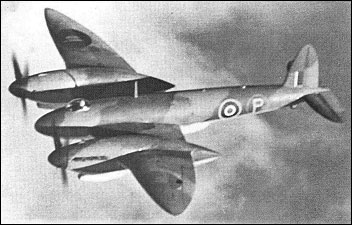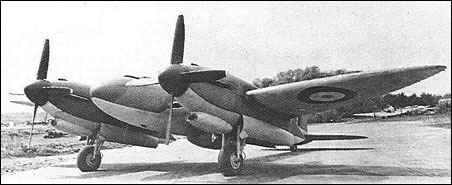|
| The final attempt by Vickers to develop a fighter for the RAF began in 1939 with a design for a twin-engined
heavy fighter featuring an armament of a 40mm Vickers cannon in a dorsal turret. As the Type 414, this corresponded with the requirements of Specification F.22/39 and gained a two-aircraft contract in 1939. Turret development began in a Wellington test-bed but, in the course of 1940, the requirement was changed via Specification F.16/40, to emphasise high-altitude performance, as there were growing fears that the Luftwaffe would be able to launch operations over Britain at altitudes beyond the capabilities of existing RAF fighters. A more conventional armament of 20mm cannon was adopted in the revised Vickers 420 design to the new specification, but further changes were called for in Specification F.7/41, including a pressure cabin. The Vickers response to this final requirement was Type 432, completely re-stressed and with an armament of six 20mm cannon in a ventral blister. The original contract for the Type 414/420s was cancelled in 1941 and a new one substituted for two Type 432s. As finally built, the Type 432 was the first Vickers aircraft of wholly stressed-skin construction, and it made use of a so-called "lobster-claw" design for the wing torsion box, in which heavy-gauge skin had a thickened section to house the span wise spar booms, giving a profile shaped like a lobster claw. The fuselage was a streamlined tube and the coolant radiators for the engines were buried within the wing. The pilot was accommodated in a relatively small, self-contained pressure cabin, his head being enclosed by a small, double-glazed dome, or "bubble", which hinged to one side for access and egress. Powered by two Rolls-Royce Merlin 61 12-cylinder Vee-type engines rated at 1520hp, the first prototype Type 432 was flown on 24 December 1942, initial trials revealing serious handling difficulties on the ground, the aircraft snaking while taxying and necessitating aft movement of the mainwheels to correct the bad tracking. The impossibility of making a three-point landing was only rectified by replacement of the Irving-type ailerons with surfaces of Westland type and alteration of tail settings. The competitive Westland Welkin was ordered into production and the second prototype of the Vickers fighter, the Type 446, was cancelled on 1 May 1943 before completion, although the first prototype was retained by Vickers for test purposes until the end of 1944. The estimated maximum speed of 700km/h at 8535m was never attained as the Merlin 61 engines did not run satisfactorily above 7010m.
 | A three-view drawing (1280 x 976) |
| WEIGHTS |
| Take-off weight | 9148 kg | 20168 lb |
| Empty weight | 7427 kg | 16374 lb |
| DIMENSIONS |
| Wingspan | 17.34 m | 57 ft 11 in |
| Length | 12.38 m | 41 ft 7 in |
| Height | 4.19 m | 14 ft 9 in |
| Wing area | 40.97 m2 | 441.00 sq ft |
| PERFORMANCE |
| Max. speed | 611 km/h | 380 mph |
| Ceiling | 11280 m | 37000 ft |
| Range | 2400 km | 1491 miles |
| Papichulo68, e-mail, 27.07.2017 01:55 Wait until you've seen its wings...this incredibly over-engineered, double-elliptical poetry of aerodynamics
P. reply | | vampire, e-mail, 17.02.2016 01:58 That is one seriously ugly plane. reply | | JOHN MANTOVA, e-mail, 22.10.2015 03:57 Maybe if the intended Griffon engines had been used it could have been a success I wouldn't mind making a model of one of these. Any detailed drawings or plans available ? reply | | Klaatu83, e-mail, 06.01.2013 02:54 It looked a bit like a Mosquito except that, while the Mosquito came out looking beautiful, somehow this simply looked all wrong. reply | |
| | Terrence I. Murphy, e-mail, 13.02.2012 18:10 It loks big, bulky, and clunky. reply | | Terrence I. Murphy, e-mail, 13.02.2012 18:10 It loks big, bulky, and clunky. reply | | soccerman, 20.06.2011 11:56 j search drawnings possible in scale of this aircraft,and if is really that it is in a MUSEUM. reply | | PG Tips, e-mail, 11.07.2008 11:51 It seems like revisiting the Supermarine type 327, but with a pressurised cabin. I'd go to Baker for that. reply | | marco, e-mail, 11.12.2006 15:03 hi,
j search drawnings possible in scale of this aircraft,and if is really that it is in a MUSEUM.
MARCO reply |
|
Do you have any comments?
|
| 
COMPANY
PROFILE
All the World's Rotorcraft
|








